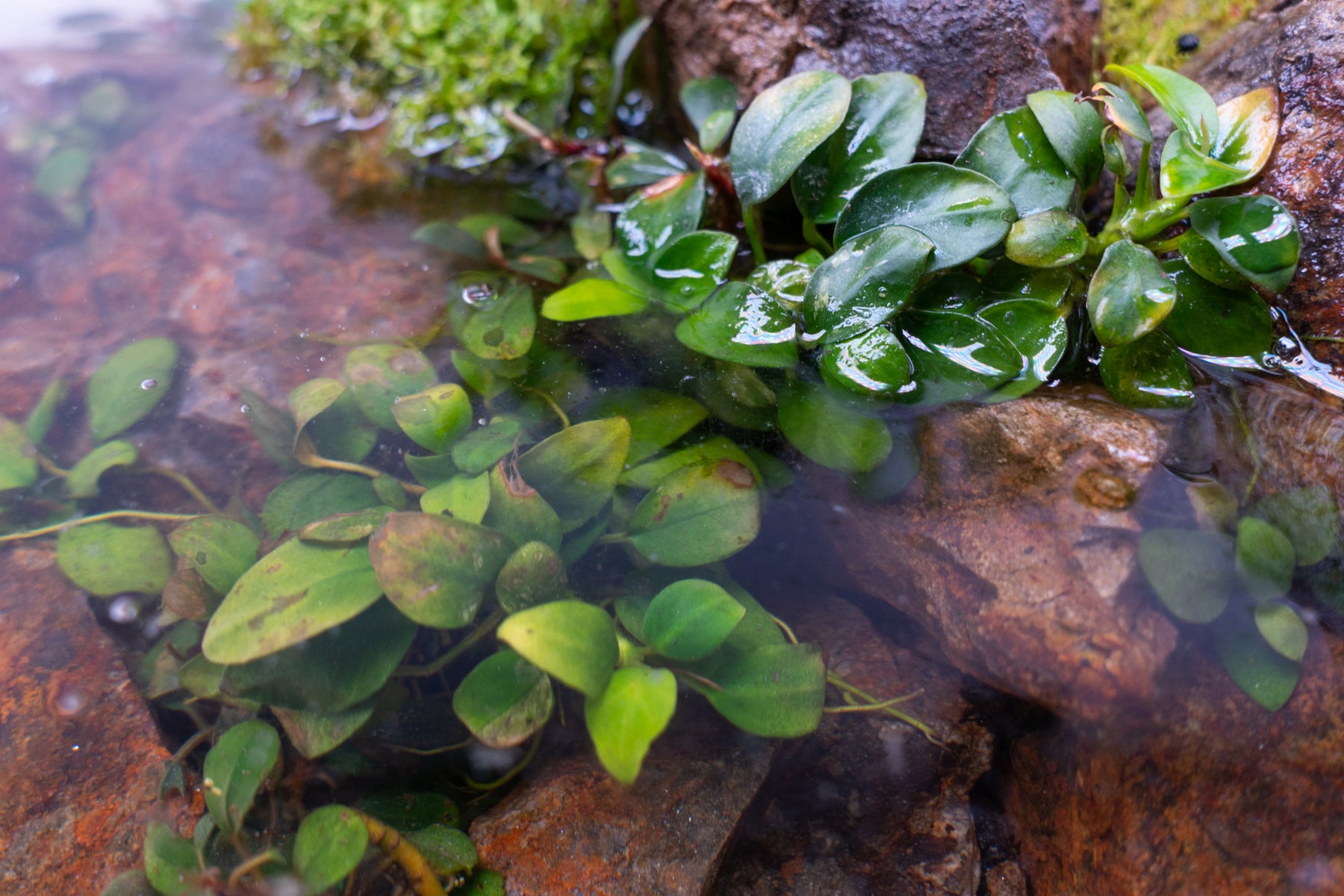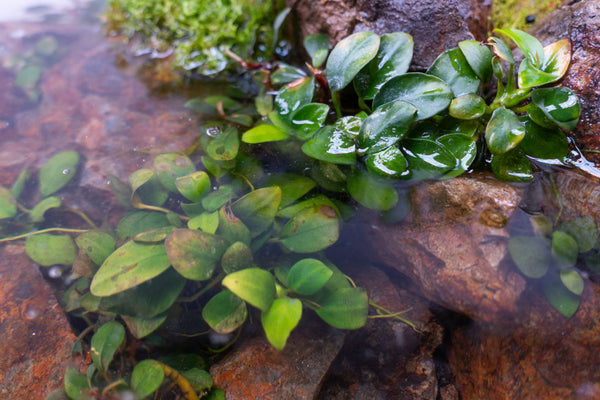
How to Prevent Aquarium Plant Melt
Written by: Tammy (@aquarist_tl) and Team Buce Plant
It is very common for planted aquarium keepers to experience the leaves of their aquatic plants turning brown and translucent, which is also referred to as “melting.” This can be discouraging to some, especially those new to the hobby. However, the process of a few leaves melting on newly added plants is actually natural in most cases. As long as the aquarium meets the proper conditions needed for the plants to thrive, they will bounce back! In this article, we will go over the main reasons why aquarium plants melt and how to prevent it when possible.
Why Do Aquarium Plants Melt?

Damage
Since plants are quite delicate, it isn’t hard for them to get injured. It can occur from fish chewing on them, or simply from being handled a little too roughly during shipment. If part of the live plant is damaged severely enough, then that segment may lose the ability to receive the necessary nutrients and compounds to stay alive. When this happens, this part of the plant will slowly start to die off.
- Tip: This is why Buce Plant offers 100% DOA (dead on arrival) protection! We want to make sure you always receive the healthiest plants possible for your tank.
Transitioning/Establishing Plants
Most of the aquarium plants we buy are grown emersed (i.e. above the surface of the water) in aquatic plant farms. When grown emersed, the plants grow much faster, remain relatively free of algae, and have a higher rate of survival when being shipped.
All of these advantages benefit the plant farms. Although, once we receive the plants, they still have to transition from their emersed form to their submerged form (i.e. below the surface of the water). This is when the melting occurs. The emersed-grown leaves are not adapted to survive underwater and will begin to decay.
- Note: Keep in mind that this is okay! New plants will usually go through a transition period when added to a new environment. Later, we will discuss how new submerged leaves will begin to replace the old emersed ones.
Nutrient Deficiencies
If the plant is past the point of having transitioned into its submerged state, but is still melting/has begun to melt, this could be due to nutrient deficiencies. Plants need a sufficient amount of each necessary nutrient to do well. If it is lacking in any, then it could prevent the plant from thriving. If you would like to go more in depth in this topic, feel free to check out our article on the different types of nutrient deficiencies HERE.
How to Prevent Plants from Melting
In general, the way we prevent plants from melting is by keeping them healthy and in the best conditions possible. Here are specific ways we can make sure they’re doing well:

1. Water Stability & the Cycled Tank
Keeping up with water changes not only helps the fish in the tank, but the plants! While plants can absorb low levels of ammonia and nitrates as food sources, too much can kill the plants. Ammonia levels increase from fish waste, decaying plants, and other organics.
It is especially important to stabilize the nitrogen levels in new planted tank setups in which active substrate can leach out ammonia and the tank is not yet cycled. During this time, the amount of nitrifying/beneficial bacteria also still needs to be established to properly convert the ammonia into nitrites and nitrates. These fluctuations in parameters can cause algae to grow. Algae can outcompete the plants in the tank for light and nutrients, which may prevent your plants from thriving.
This is why planting in a cycled tank, especially those using a nutrient-rich aquasoil, can prevent plant melt due to high levels of ammonia. To learn more about how to cycle your tank.
2. Trimming and Pruning
Trimming off old and dying leaves or stems will encourage the plant to grow! If you see an old leaf that's yellowing or has been damaged, it's best to snip it off. When a leaf or stem is damaged or dying, the plant will still waste some of its resources into trying to fix it. Help your plants redirect their resources into growing new, healthy leaves by trimming old and dying leaves.
In the case of newly purchased plants with emersed-grown leaves, try cutting off a few of these leaves before planting. For stem plants especially, trim the ends before planting to give them a fresh start. While planting, make sure to separate the stems and plant at least 0.5" apart from each other. This allows for easier water flow, avoids overcrowding, and access to better light.
Once you see a decent amount of new submerged growth, then you can remove the rest of the emersed-grown leaves that may melt away. A few professional aquascapers actually trim all the leaves off of certain plant species like crypts, leaving only the roots. This way, they do not have to deal with any of the crypt melt that usually occurs, and the plant will only have submerged-grown leaves.

3. Add Necessary Nutrients
Aquatic plants need the proper amount of essential nutrients to do well in the aquarium. They intake these nutrients in two ways: through the water column or through the substrate.
Plants like epiphytes can absorb nutrients straight from the water. To make sure there’s a sufficient amount of each nutrient, it is recommended to dose the aquarium water with fertilizer like the Aquario Neo line. For the remainder of plants like echinodorus and crypts, using a planted tank substrate like Controsoil in your scape is ideal. It is loaded with nutrients for the plant's roots to feed off of.
4. Use Proper LED Lighting
LED Lighting plays an instrumental part in plant health. Balance is key; too little light can result in melting or stunted growth, and too much can cause algae to bloom. LED lights that are designed for aquatic plant growth have a wavelength that is set to be within a certain range that’s best for photosynthesis. They also make the colors of the plants pop out more, so you can fully appreciate your planted tank and its inhabitants!

5. Consider CO2 Injection
Injecting CO2 into the aquarium boosts the growth rate of aquatic plants. Plants grow more rapidly with CO2 being diffused in the water, and do much better in general. It is definitely a game-changer in the world of planted tanks.
Your aquatic plants can grow 5-10 times faster by supplementing CO2, meaning their transition time lessens and your plants will grow happier and healthier (even in tanks with low tech plants!) More lighting means the plants grow quicker, so there is more demand for resources. Because of this, adding CO2 to can result in less algae and less melting in the planted aquarium.
6. Avoid Moving Plants
Once a plant is added into the substrate, it can take a while to establish and actually may not start growing until it is fully settled (or rooted). So, if you move the plant out of its place and into another before it has a healthy root system, it then has to start over and reestablish itself in its new spot. During this time, melting may occur so it’s always best to try to avoid moving the plant unless absolutely necessary.
Plant melt is often a concerning factor for many aquarists, but if you’re giving your plants light, nutrients, and stable water conditions then you should have nothing to worry about. Hopefully this article helps out anyone struggling with plant melt.
Has this article helped you? Please leave a comment below!
If you have any questions regarding this article, please DM us on Instagram or Facebook so we can assist you! @buceplant





Comments
Leave a comment